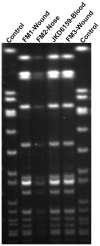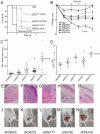The dominant Australian community-acquired methicillin-resistant Staphylococcus aureus clone ST93-IV [2B] is highly virulent and genetically distinct
- PMID: 21991381
- PMCID: PMC3185049
- DOI: 10.1371/journal.pone.0025887
The dominant Australian community-acquired methicillin-resistant Staphylococcus aureus clone ST93-IV [2B] is highly virulent and genetically distinct
Abstract
Community-associated methicillin-resistant Staphylococcus aureus (CA-MRSA) USA300 has spread rapidly across North America, and CA-MRSA is also increasing in Australia. However, the dominant Australian CA-MRSA strain, ST93-IV [2B] appears distantly related to USA300 despite strikingly similar clinical and epidemiological profiles. Here, we compared the virulence of a recent Australian ST93 isolate (JKD6159) to other MRSA, including USA300, and found that JKD6159 was the most virulent in a mouse skin infection model. We fully sequenced the genome of JKD6159 and confirmed that JKD6159 is a distinct clone with 7616 single nucleotide polymorphisms (SNPs) distinguishing this strain from all other S. aureus genomes. Despite its high virulence there were surprisingly few virulence determinants. However, genes encoding α-hemolysin, Panton-Valentine leukocidin (PVL) and α-type phenol soluble modulins were present. Genome comparisons revealed 32 additional CDS in JKD6159 but none appeared to encode new virulence factors, suggesting that this clone's enhanced pathogenicity could lie within subtler genome changes, such as SNPs within regulatory genes. To investigate the role of accessory genome elements in CA-MRSA epidemiology, we next sequenced three additional Australian non-ST93 CA-MRSA strains and compared them with JKD6159, 19 completed S. aureus genomes and 59 additional S. aureus genomes for which unassembled genome sequence data was publicly available (82 genomes in total). These comparisons showed that despite its distinctive genotype, JKD6159 and other CA-MRSA clones (including USA300) share a conserved repertoire of three notable accessory elements (SSCmecIV, PVL prophage, and pMW2). This study demonstrates that the genetically distinct ST93 CA-MRSA from Australia is highly virulent. Our comparisons of geographically and genetically diverse CA-MRSA genomes suggest that apparent convergent evolution in CA-MRSA may be better explained by the rapid dissemination of a highly conserved accessory genome from a common source.
Conflict of interest statement
Figures




Similar articles
-
The molecular epidemiology of the highly virulent ST93 Australian community Staphylococcus aureus strain.PLoS One. 2012;7(8):e43037. doi: 10.1371/journal.pone.0043037. Epub 2012 Aug 10. PLoS One. 2012. PMID: 22900085 Free PMC article.
-
Hyperexpression of α-hemolysin explains enhanced virulence of sequence type 93 community-associated methicillin-resistant Staphylococcus aureus.BMC Microbiol. 2014 Feb 10;14:31. doi: 10.1186/1471-2180-14-31. BMC Microbiol. 2014. PMID: 24512075 Free PMC article.
-
Adaptive change inferred from genomic population analysis of the ST93 epidemic clone of community-associated methicillin-resistant Staphylococcus aureus.Genome Biol Evol. 2014 Feb;6(2):366-78. doi: 10.1093/gbe/evu022. Genome Biol Evol. 2014. PMID: 24482534 Free PMC article.
-
Virulence strategies of the dominant USA300 lineage of community-associated methicillin-resistant Staphylococcus aureus (CA-MRSA).FEMS Immunol Med Microbiol. 2012 Jun;65(1):5-22. doi: 10.1111/j.1574-695X.2012.00937.x. Epub 2012 Mar 5. FEMS Immunol Med Microbiol. 2012. PMID: 22309135 Free PMC article. Review.
-
Basis of virulence in community-associated methicillin-resistant Staphylococcus aureus.Annu Rev Microbiol. 2010;64:143-62. doi: 10.1146/annurev.micro.112408.134309. Annu Rev Microbiol. 2010. PMID: 20825344 Review.
Cited by
-
Comparative analysis of the first complete Enterococcus faecium genome.J Bacteriol. 2012 May;194(9):2334-41. doi: 10.1128/JB.00259-12. Epub 2012 Feb 24. J Bacteriol. 2012. PMID: 22366422 Free PMC article.
-
The molecular epidemiology of the highly virulent ST93 Australian community Staphylococcus aureus strain.PLoS One. 2012;7(8):e43037. doi: 10.1371/journal.pone.0043037. Epub 2012 Aug 10. PLoS One. 2012. PMID: 22900085 Free PMC article.
-
Comparative genomics of the Staphylococcus intermedius group of animal pathogens.Front Cell Infect Microbiol. 2012 Apr 18;2:44. doi: 10.3389/fcimb.2012.00044. eCollection 2012. Front Cell Infect Microbiol. 2012. PMID: 22919635 Free PMC article.
-
Improved Genome Sequence of Australian Methicillin-Resistant Staphylococcus aureus Strain JKD6159.Microbiol Resour Announc. 2023 Feb 16;12(2):e0112922. doi: 10.1128/mra.01129-22. Epub 2023 Jan 18. Microbiol Resour Announc. 2023. PMID: 36651736 Free PMC article.
-
The population genetics of drug resistance evolution in natural populations of viral, bacterial and eukaryotic pathogens.Mol Ecol. 2016 Jan;25(1):42-66. doi: 10.1111/mec.13474. Epub 2015 Dec 17. Mol Ecol. 2016. PMID: 26578204 Free PMC article. Review.
References
-
- Moran GJ, Krishnadasan A, Gorwitz RJ, Fosheim GE, McDougal LK, et al. Methicillin-resistant S. aureus infections among patients in the emergency department. N Engl J Med. 2006;355:666–674. - PubMed
-
- Voyich JM, Otto M, Mathema B, Braughton KR, Whitney AR, et al. Is Panton-Valentine leukocidin the major virulence determinant in community-associated methicillin-resistant Staphylococcus aureus disease? J Infect Dis. 2006;194:1761–1770. - PubMed
-
- Labandeira-Rey M, Couzon F, Boisset S, Brown EL, Bes M, et al. Staphylococcus aureus Panton-Valentine leukocidin causes necrotizing pneumonia. Science. 2007;315:1130–1133. - PubMed
Publication types
MeSH terms
LinkOut - more resources
Full Text Sources
Medical

